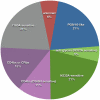A limited number of antibody specificities mediate broad and potent serum neutralization in selected HIV-1 infected individuals
- PMID: 20700449
- PMCID: PMC2916884
- DOI: 10.1371/journal.ppat.1001028
A limited number of antibody specificities mediate broad and potent serum neutralization in selected HIV-1 infected individuals
Abstract
A protective vaccine against HIV-1 will likely require the elicitation of a broadly neutralizing antibody (bNAb) response. Although the development of an immunogen that elicits such antibodies remains elusive, a proportion of HIV-1 infected individuals evolve broadly neutralizing serum responses over time, demonstrating that the human immune system can recognize and generate NAbs to conserved epitopes on the virus. Understanding the specificities that mediate broad neutralization will provide insight into which epitopes should be targeted for immunogen design and aid in the isolation of broadly neutralizing monoclonal antibodies from these donors. Here, we have used a number of new and established technologies to map the bNAb specificities in the sera of 19 donors who exhibit among the most potent cross-clade serum neutralizing activities observed to date. The results suggest that broad and potent serum neutralization arises in most donors through a limited number of specificities (1-2 per donor). The major targets recognized are an epitope defined by the bNAbs PG9 and PG16 that is associated with conserved regions of the V1, V2 and V3 loops, an epitope overlapping the CD4 binding site and possibly the coreceptor binding site, an epitope sensitive to a loss of the glycan at N332 and distinct from that recognized by the bNAb 2G12 and an epitope sensitive to an I165A substitution. In approximately half of the donors, key N-linked glycans were critical for expression of the epitopes recognized by the bNAb specificities in the sera.
Conflict of interest statement
The authors declare competing financial interests. LMW, SKP, PP, and DRB are inventors on a patent describing the human broadly neutralizing antibodies PG9 and PG16 (U.S. provisional patent application numbers USSN 61/161,010; USSN 61/165,829; and USSN 61/224,739).
Figures









References
Publication types
MeSH terms
Substances
Grants and funding
LinkOut - more resources
Full Text Sources
Other Literature Sources
Research Materials

